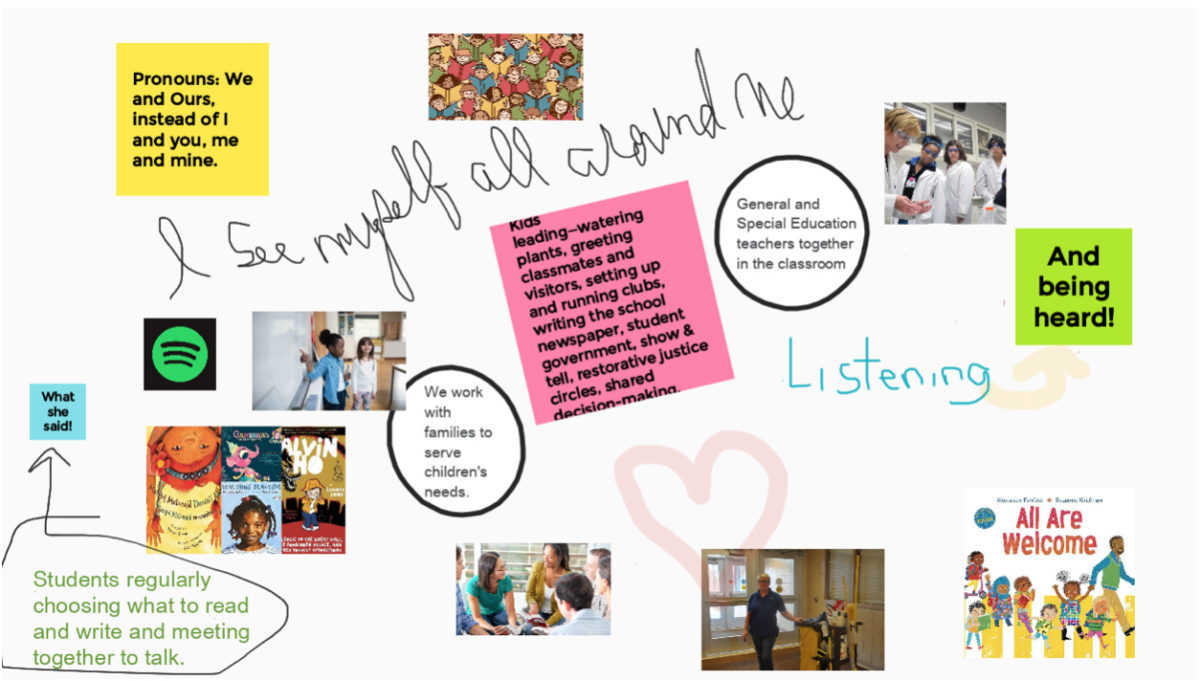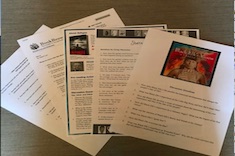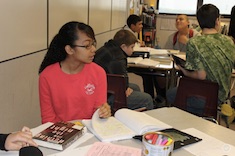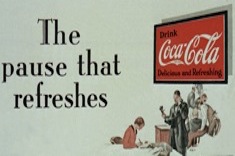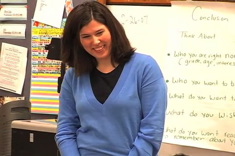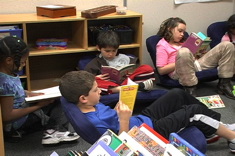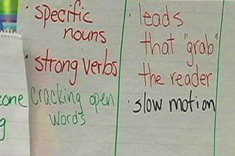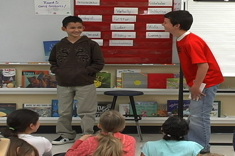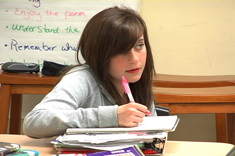Suzy Kaback
Suzy Kaback is a literacy teacher educator and a co-director of a Registered Apprenticeship Program for Teaching at the University of St. Thomas in Minnesota.
All Content
Bingo! Games to the Rescue
Teacher Educators Teach | Suzy Kaback was inspired to use play as a tool—one that can reframe routine, refocus attention, and give both teachers and students a fresh lens.
Acts of Service: AI and Student Feedback
Suzy Kaback offers a thoughtful review of using AI for giving feedback on student writing and a reflection for making it a wise and practical use of technology. Suzy offers a list of articles to help each of us develop our own understanding and stance on using AI for feedback on student writing.
All the Writing Things: Putting Writers in Charge of Their Writing
Inspired by coding time, Suzy Kaback works with her students to develop an All the Writer Things tool to help writers reflect on their work as writers and become stronger and more efficient.
Connecting with the Goals of the School Community
Teacher Educators Teach | Suzy Kaback shares details to help students connect with a school community. In this article full of templates and student examples, she taps the power of listening walks and empathy interviews.
Slide Decking: Getting Writing Started
Getting writing started is often the biggest challenge for writers of all ages and experiences. Suzy Kaback offers a process called slide decking with her in-service teacher colleagues as a way to plan the content of an essay or article.
It All Counts: Getting to Know Your Teacher Candidates
Teacher Educators Teach | Suzy Kaback shares ways professors can get to know teacher candidates, as well as the research behind mattering and the important connection to building relationships as educators.
Developing Transcripts of Classroom Teaching with AI
Suzy Kaback provides a guide for using an AI chatbot to help generate transcripts to study explicit instructional moves. Download a progression to learn how to refine requests to create a high-quality transcript. This is the third installment in a series about using AI with teacher candidates.
AI in Teacher Prep
Suzy Kaback guides us in learning to use ChatGPT as a thought partner. She offers a compelling rationale, clear step-by-step directions, and resources to build a deeper understand of using AI to prepare for instruction. This is the second installment in a series about using AI with teacher candidates.
Meet Stevie, Our Imaginary AI Friend
Inspired by a third-grade teacher, Suzy Kaback uses AI to generate an imaginary student to engage her teacher candidates as they mediate teaching and learning through a proxy. This is the first installment in a series about using AI with teacher candidates.
The Language We Use and How It Strengthens Understanding
Suzy Kaback explores the importance of the way teachers use language and invite kids to use theirs. It is the key to knowing ourselves, tuning in to others, and understanding the larger world.
Getting to Know You . . . More: A Midyear Idea for Helping Kids Tune (Back) In to Each Other
Helping students tune into each other is both an anchor for building classrooms where caring is common, and where, as a result, learning blooms. Suzy Kaback gives suggestions for creating conditions where students can get to know each other more throughout the school year.
Transcripts as a Coaching Tool
Suzy Kaback shares a process to use transcripts as a coaching tool. Tips from her own experiences and several resource links will have you using this tool, too.
Belonging in a School Community
Suzy Kaback thinks deeply about the concept of belonging as an essential part of building a school community.
There You Are
Suzy Kaback uses the “My Life in Seven Stories” exercise from Jennifer Allen to coax teachers to write, share drafts, and connect their learning to crafting writing in classrooms.
Fact or Fiction?
Suzy Kaback works with students to create a “fact or fiction” class book to explore the boundaries between truth and fantasy.
Call Me by My Name
Suzy Kaback reminds us that the language we use to talk about challenging students shapes our perceptions of them. That’s why she has moved to calling students “small teachers.”
Find Friends
Suzy Kaback shares how we can translate the values we hold dear into action, even when our social and professional norms are in upheaval.
Forces of Nature
Literacy can be seen as a “curricular bully” by science and math teachers, taking over the curriculum and many professional development sessions. Suzy Kaback faces that challenge when she adds poetry writing and visual arts to a session for STEM educators.
Starting with Consensus
Suzy Kaback finds that consensus mapping is a powerful tool for leading teachers through any change process.
Secret Reader
Suzy Kaback marvels at a very young learner who is a “secret reader,” and this leads her to reassess the value of constantly celebrating new skills in school communities.
Identity and Coaching
Suzy Kaback considers how the way we talk about ourselves shapes our identity in subtle ways, and what this might mean for coaching teachers.
Readers’ Guides: Helping Students Think About Informational Text
Suzy Kaback finds the task of creating readers’ guides helps students in the intermediate grades think about evidence in texts in more sophisticated ways.
Shoulders-Down Spaces
Suzy Kaback feels rising unease as a tourist in unfamiliar neighborhoods. The experience provokes empathy for students who find classrooms strange or uncomfortable.
Ohana Means “Family”
Suzy Kaback is startled to see a picture of her deceased father on the wall when she visits her daughter’s seventh-grade classroom. It’s the start of learning about the power of ohana in schools.
My World Maps
Creating “world” maps is a great way to explore the territories beyond school that matter most to everyone in your classroom. Suzy Kaback explains how to create them with students early in the year as a way to get to know them as learners and community members.
Puppy Chow
How do you know an assignment is authentic and worthy of your students' time? Suzy Kaback explains why you need to try it out yourself first.
The Coconut Wireless
Suzy Kaback finds that a novel take on community communication changes her outlook on how to reach teachers through informal networks.
The Writing Workout
Suzy Kaback meets with a group of teachers to talk through struggles in the writing workshops. Using a fitness analogy, they come up with strategies to try immediately in their classrooms.
You Say Tornado . . .
Suzy Kaback shares the power of taking time to honor results late in the school year with teachers in professional development settings.
Recipes and Lesson Plans: Process and Practice
Suzy Kaback is inspired by chefs testing recipes to develop a lesson analysis activity. She shares an example of how it works, encouraging honesty and risk-taking among new teachers.
Where the Magic Happens
Suzy Kaback considers her own history as a learner and the needs of her teenage daughter as she mulls over the best ways to help the new teachers she leads take risks in their teaching.
The Professional Promise of Podcasts
Suzy Kaback discovers podcasts are invaluable for building her knowledge of social justice. She provides links to many of her favorite online sources to explore.
Frog and Toad and Tina and Maya: A Precocious Kindergarten Reading Group
Suzy Kaback ponders the precociousness of two kindergarten readers.
A Case of the Perennial Annuals
Suzy Kaback remembers saying goodbye to her first group of students as a young teacher.
The Pause That Refreshes: Write When the Conversation Gets Hot
When’s the best time for some spontaneous opinion writing? Suzy Kaback argues it’s when class conversations get hot.
Teaching the Genes
Suzy Kaback rethinks the concept of "managed choice" in writing workshops.
Laundry Line Luxuries
Suzy Kaback writes about the pleasures of slowing down and being inefficient sometimes in teaching and relationships.
Fresh Books and Age-old Skills
Suzy Kaback provides a booklist of newer texts that can be used to teach multiple reading strategies.
Photovoice: Exploring Content Literacy with Images
As Suzy Kaback explores the question “How does your expertise function?” she explains the power of Photovoice and details its use in K-12 classrooms.
Mentoring from the Real to the Ideal: Mental Images of Teaching
We know the power of mental images as a strategy for helping readers comprehend difficult text. Suzy Kaback uses a similar technique to help novice teachers envision success. Thisl is an activity you might want to try with a new teacher group.
Conversation Turns: Recordkeeping and Analysis Tool
Suzy Kaback provides a template for helping students note and reflect upon their talk.
The Draw-a-Reader Test: Informal Assessment Supporting Teacher Inquiry
The Draw-a-Reader test from Suzy Kaback is a fun way to get to know the readers of any age that also provides insight into their background knowledge and personal reading histories.
Self-Fulfilling Prophecies: Recommending Yourself
Suzy Kaback asks her students to write letters of recommendations for themselves, and finds that the activity ripples across the school mentoring community. This exercise is a terrific catalyst for creating personal improvement plans.
Writing Strengths Anchor Chart
Suzy Kaback's anchor chart activity builds a sense of community and peer editing connections in her middle school classroom.
The Anticipation Guide: A Tool for Study Group Leaders
Suzy Kaback finds the Anticipation Guide is the “little black dress” of study group and staff development leaders, taking any literacy leader seamlessly from the classroom to PLCs and faculty meetings.
The “All About Us” Board: Linking Literacy and Community Building All Year Long
Suzy Kaback has terrific tips for an ever-evolving “All About Us” bulletin board to use from the first day of school to the last.
Important Book, Important Notes: Guiding Young Students Through Notetaking
Suzy Kaback catches a young learner near and dear to her in the process of plagiarizing. She uses the experience to develop a template to help students and colleagues with notetaking.
Prepping a Fieldwork Site: Strategies for Launching Quality Partnerships
Teacher Educators Teach | Suzy Kaback reminds us that launching a fieldwork site is a critical first step in building respectful, relevant partnerships that invite complex learning. “What does this space encourage?” is a helpful question to guide the launch.
Overcorrecting
“Did I do anything right?” Suzy Kaback receives a note from a gifted teacher that gives her pause. Suzy wonders if avoiding praise is damaging her relationships with teachers. She decides to give more feedback for continuation, which is praise’s smarter cousin for coaches.
The Sharpening Stone
Summer is rushing along. Are you feeling restored or refreshed yet for the new year? Suzy Kaback writes about the power of the sharpening stone.
Tapping Novelty for What Teachers Need
Suzy Kaback engages in the power of novelty to uproot dissatisfaction during curriculum meetings. It begins by asking, “What do teachers need?” and then providing time to meet their needs.
Opening Moments
Suzy Kaback transfers an instructional practice from her elementary classroom to her college classrooms for preservice teachers. Read about the variety of ways Opening Moments can engage, teach, and build community with students of all ages.




